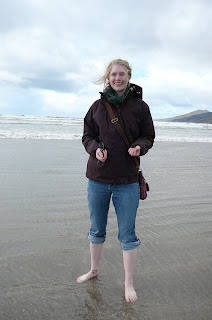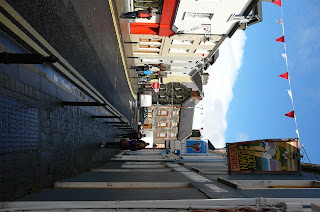We
decided to visit more of the coast by exploring the Dingle Peninsula. The
westernmost end is a “Gaeltacht” – an area where Irish is the predominant
language. According to our host, many children come to be tutored in Gaelic
here. (Click pictures to enlarge.)
On our
way out of the Killarney area, we stopped to see a group of standing stones engraved
with Ogham – a form of writing
consisting of lines and strokes which was present in Ireland when Christianity
came in the 5th century. Each stone has a name inscribed on it, and
may have been used as a grave marker.

Our
next stop was Inch Strand. A “strand” is a beach, which soon became pretty
clear to all our native German speakers, because it’s the same word in German! It’s
a pretty long beach, and some people even drove their cars out to park on the
sand! When we arrived it was raining sporadically, but by the time we got out,
the clouds had rolled back and we actually got a bit of sun.



P was the first to
take off his socks and shoes, and Tiny was quick to follow. After getting lots
of shots of the two of them running into the water, I figured it was time to
get my feet wet too. J The water was so much
warmer than I expected! (We found out later that it was an inlet.) A and I then
started hunting for shells, and found quite a few with a lovely dark blue
colour. Oyster shells?
 |
| "Hold this!" |
 |
| Tiny preparing to enter the icy April water... |
 |
| "Hey, not so bad!" |
 |
| "Race ya!" |
 |
| M joins. (Photo: E) |
 |
| Shoes abandoned! (Photo: A) |
 |
| Never a case of cold feet. :-) |
 |
| Tiny in the sun! |
We
drove to Dingle and stopped for lunch. We wandered around the town, exploring the
shops (many selling wool sweaters) and walking out to the harbour. There are
all sorts of sea creatures in right in the harbour itself, including dolphins,
seals, and herons – though we weren’t lucky enough to see any that day.
 |
| Close to Dingle. |
 |
| The harbour. |
 |
| Brrr.....;-) |
 |
| Little windy? ;-) |
 |
| Dingle. |
 |
Dingle's own Mad Hatters!
Remember those tiny hats the British Royals
wore to Willian & Kate's wedding? ;-) |
 |
| Tea! |
 |
| Coffee! |



Driving
further west, we stopped to see the beehive huts. They date back to the early Middle
Ages at least, but many archaeologists believe these kinds of round stone
houses were built as early as the Bronze Age. Further along the road, we got a
glimpse of the Blasket Islands, which until the ‘50s were occupied by an
entirely Irish-speaking population. (Emigration from the island
diminished the community, and in 1953 the last 22 inhabitants abandoned the island.)

 |
| Beehive hut. |


 |
| Photo: P |
 |
| Photo: P |
 |
| Photo: A |
 |
| Coming to investigate...;-) |
 |
| Blasket Islands. |
 |
| Siblings. :-) |
We took
a break to stretch our legs and climb some rocks…fantastic view of the sea!























































No comments:
Post a Comment